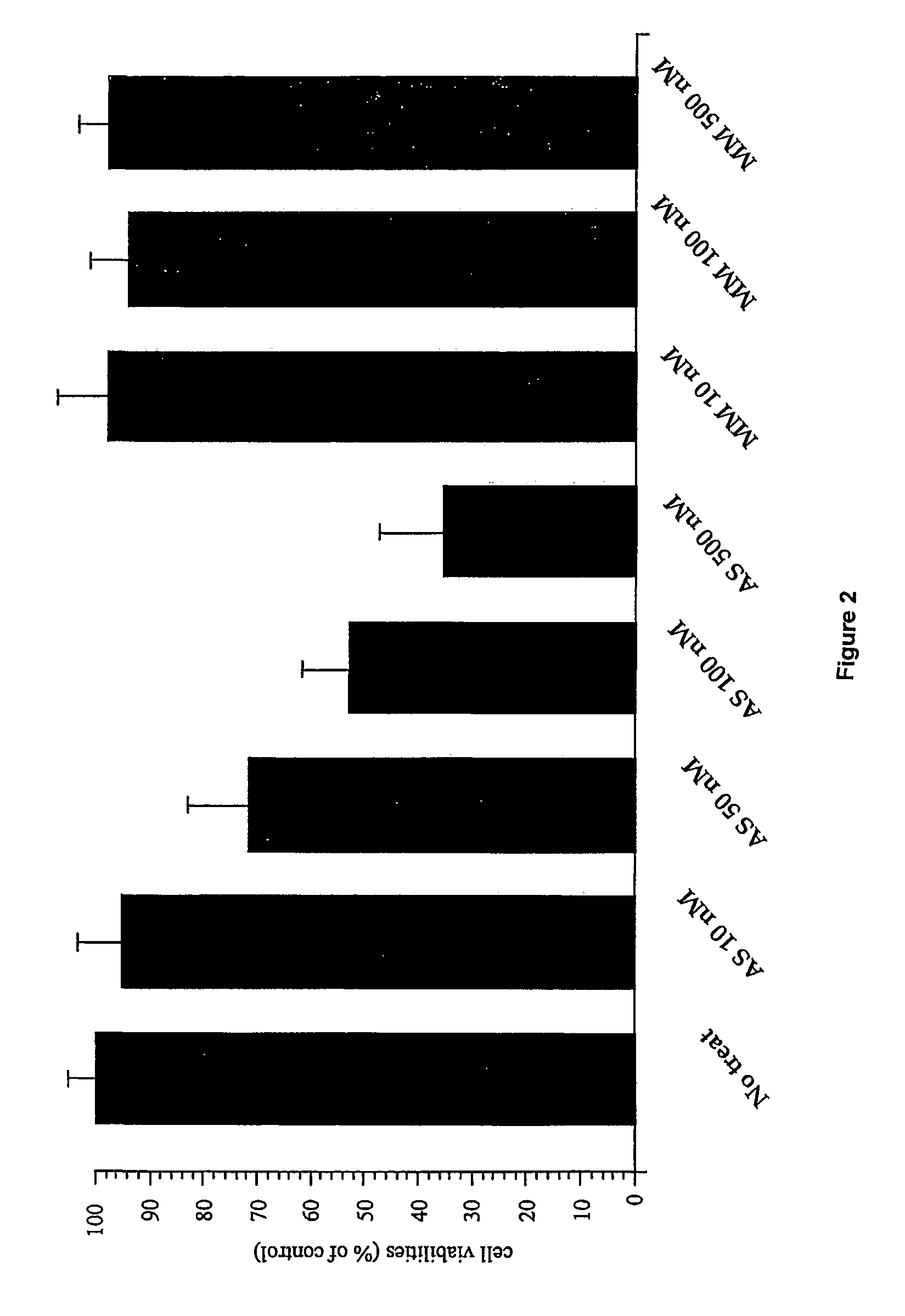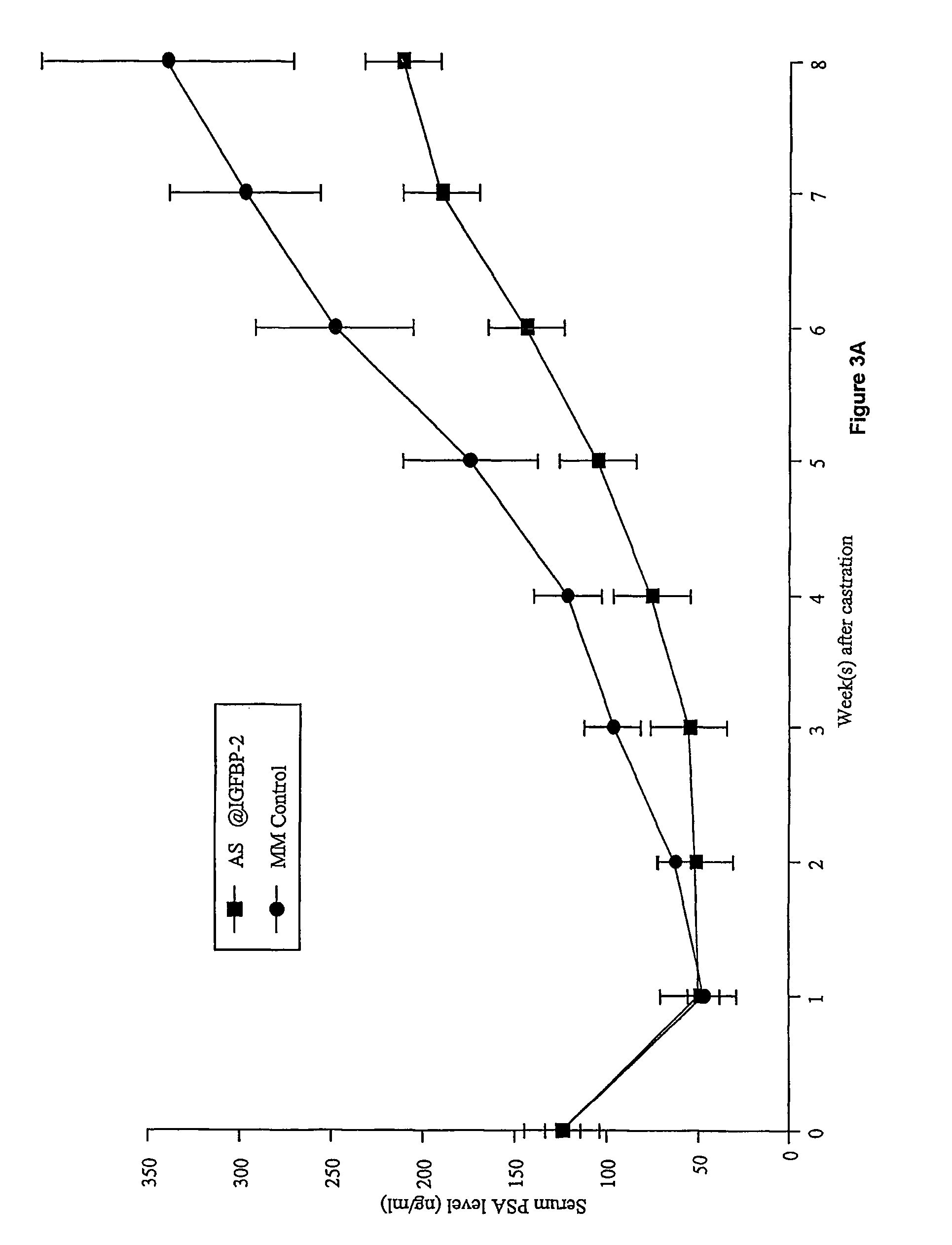Antisense insulin-like growth factor binding protein (IGFBP)-2-oligodeoxynucleotides for prostate and other endocrine tumor therapy
- Summary
- Abstract
- Description
- Claims
- Application Information
AI Technical Summary
Benefits of technology
Problems solved by technology
Method used
Image
Examples
example 1
[0022]Three oligonucleotides were prepared with the sequences given in Seq. ID. Nos. 1–3. Seq. ID No. 1 spans the translation initiation site of the IGFBP-2 mRNA starting with base number 64. Seq. ID Nos. 2 and 3 correspond to bases 131–151 and 630–650 respectively. Two base IGFBP-2 mismatch oligonucleotides (Seq. ID Nos. 57–59) were also prepared as controls.
[0023]Initial screening on these three oligonucleotides was done using LNCAP cells. Lipofectin, a cationic lipid (Life Technologies Inc. Gaithersburg, Md.) was used to increase uptake of the oligonucleotides into the cells. LNCaP cells were treated with one of the three oligonucleotides (Seq. ID. Nos. 1–3), 1000 nM, or the corresponding mismatch control (Seq. ID Nos. 57–59). Total RNA was extracted and analyzed by Northern Blot analysis for levels of IGFBP-2 encoding RNA. Glyceraldehyde-3-phosphate dehydrogenase (G3PDH) was used as a control. The probes used had the sequences given by Seq. ID. Nos. 60–63. The RNA blots were hyb...
example 2
[0025]The LNCaP model is an androgen-sensitive, PSA-secreting, human prostate cancer cell line that can be induced to form tumors in athymic mice under a variety of conditions. Like in human prostate cancer, serum PSA levels in this model are regulated by androgen and are directly proportional to tumor volume. After castration, serum and tumor-cell PSA levels decrease up to 80% and remain suppressed for 3–4 weeks. Beginning 4 weeks after castration, however, PSA production gradually increases above pre-castrate levels in the absence of testicular androgens, heralding the onset of androgen-independent progression. The pattern of changes in gene expression after castration in the LNCaP model is similar to that in the Shionogi system, with increased expression of Bcl-2, TRPM-2, and IGFBP-2 following castration of mice bearing LNCaP tumors. It is important to stress that many of the changes in gene expression in the LNCaP and Shionogi models also occur in human prostate cancer (e.g, Bcl...
example 3
[0026]The Shionogi tumor model mimics human prostate cancer and provides a very useful model for the evaluation of the ability of compounds to delay the onset of androgen-independence. Despite complete tumor regression after castration, rapidly growing androgen-independent Shionogi tumors invariably recur after one month, which provides a reliable end point to evaluate agents which can delay the progression to androgen-independence. In the study leading to the present invention, we initially characterized changes of IGFBP expression in the Shionogi tumor model after castration and during AI progression. Northern blot analyses were used to characterize changes in IGFBP mRNA expression in AD intact tumors before castration, regressing tumors 4 and 7 days after castration, and AI recurrent tumors 28 days after castration. IGFBP-2 levels increased up to 2–3 fold in androgen-independent tumors compared to androgen dependent tumors prior to castration, suggesting IGFBP-2 increases may be ...
PUM
| Property | Measurement | Unit |
|---|---|---|
| Cell death | aaaaa | aaaaa |
| Sensitivity | aaaaa | aaaaa |
Abstract
Description
Claims
Application Information
 Login to View More
Login to View More - R&D
- Intellectual Property
- Life Sciences
- Materials
- Tech Scout
- Unparalleled Data Quality
- Higher Quality Content
- 60% Fewer Hallucinations
Browse by: Latest US Patents, China's latest patents, Technical Efficacy Thesaurus, Application Domain, Technology Topic, Popular Technical Reports.
© 2025 PatSnap. All rights reserved.Legal|Privacy policy|Modern Slavery Act Transparency Statement|Sitemap|About US| Contact US: help@patsnap.com



